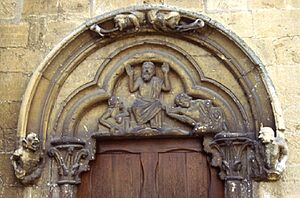John of Gorze facts for kids
Quick facts for kids Saint John of Gorze |
|
|---|---|
| Abbot | |
| Born | 900 Vandières, Meurthe-et-Moselle |
| Died | 7 March 974 |
| Venerated in | Roman Catholic Church |
| Feast | 27 February |
Saint John of Gorze (also known as John of Lorraine) was a famous monk born around 900 in Lorraine. He was also a skilled diplomat and helped improve monasteries. He passed away on March 7, 974.
Contents
Life of Saint John of Gorze
John of Gorze was born in a town called Vandières in Lorraine. His family was wealthy and well-known in the area. His parents made sure he received a good education.
He studied at the Benedictine monastery of Saint-Mihiel in Metz. This monastery was known for its excellent teaching. John's teacher, Hildebold, had even studied in Paris.
By the time he was twenty, John had already met important people. These included Count Ricuin of Verdun and Bishop Dado of Verdun. In 933, John decided to become a Benedictine monk at Gorze Abbey. He gave up his wealth and went on a special trip to Rome and Monte Cassino before joining the monastery.
At Gorze Abbey
John was looking for a monastery with very strict rules. He met other people who felt the same way, like Einald, who was a church leader from Toul.
In 933, Bishop Adelbero of Metz asked John and Einald to help fix up and improve the Gorze monastery. It had fallen into disrepair. Einald became the abbot, and John was his main helper.
More and more monks joined Gorze Abbey. The improvements they made there spread to other monasteries. In 950, Pope Agapetus II even asked monks from Gorze to help improve a monastery in Rome.
John's Special Skills
People said John had a photographic memory. This means he could remember things perfectly, like a picture. He also created a system for keeping track of money and managing investments.
It was said that when he read the Psalms, the quiet sound of his lips was like the buzzing of a bee.
Diplomatic Mission to Al-Andalus

In 953, King Otto I sent John as an ambassador to the Caliph Abd-ar-Rahman III in Córdoba. An ambassador is a person who represents their country in another country. John stayed there for three years.
John traveled a long way through many cities like Langres, Dijon, Lyon, Avignon, and Barcelona. From Barcelona, he went to Tortosa, then Zaragoza, and finally to Córdoba.
The main goal of this trip was to stop attacks from a group of adventurers. These attackers were based in a place called Fraxinet. John arrived in Córdoba with a letter from King Otto and valuable gifts. He lived in a beautiful palace near the Caliph's own palace.
The Caliph's ambassador, Hasdai ibn Shaprut, met with John. The Caliph was worried that King Otto's letter might say something disrespectful about Islam. So, he asked Hasdai to talk to John first. Hasdai quickly realized the letter could not be given to the Caliph as it was. He convinced John to send for a new letter that would not cause any problems. John of Gorze said he had "never seen a man of such subtle intellect as the Jew Hasdeu."
Later Life and Legacy
John became the abbot of Gorze Abbey in 960, after Einald passed away. He died naturally on March 7, 974.
His special day, or feast day, is celebrated on February 27. Another abbot named John, from St. Arnulph in Metz, wrote a book about John of Gorze's life.


